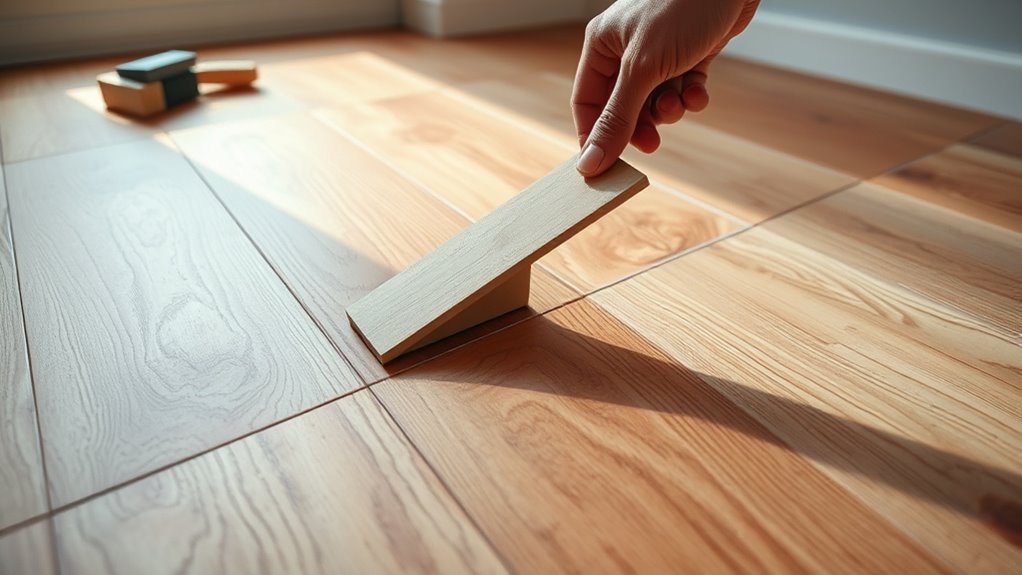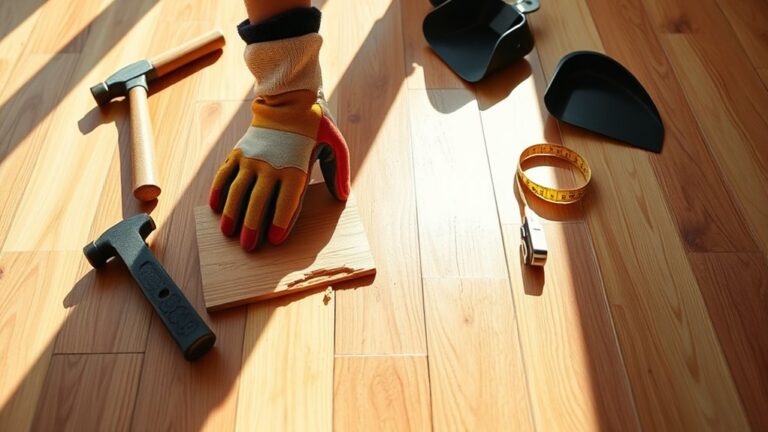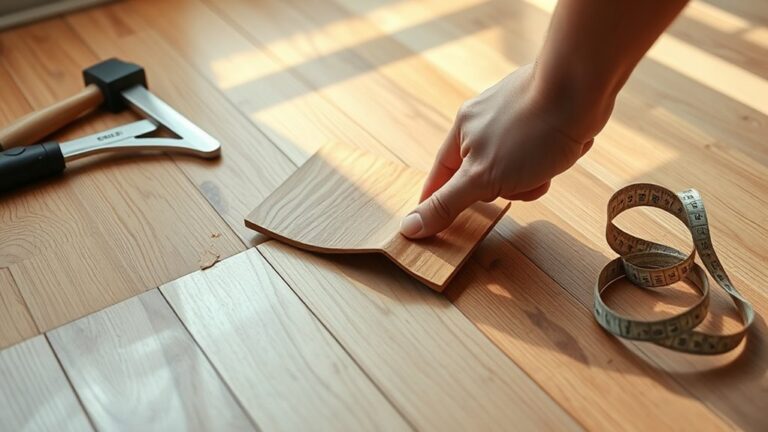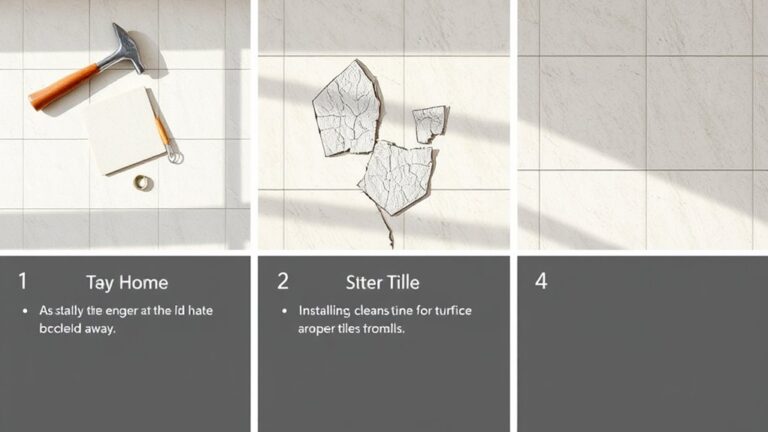To fix laminate floor gaps, first identify the cause—humidity changes or installation issues. Gather tools like a rubber mallet, spacers, and wood filler if needed. Clean gaps thoroughly with a vacuum and brush. For small gaps, apply color-matched wood filler smoothly and let it cure. For larger gaps, remove baseboards, pry up planks, realign them securely, then reinstall trim. Maintain proper humidity levels to prevent recurrence. Following these precise steps guarantees a lasting repair; detailed guidance can help you master the process.
Identify the Cause of the Gaps
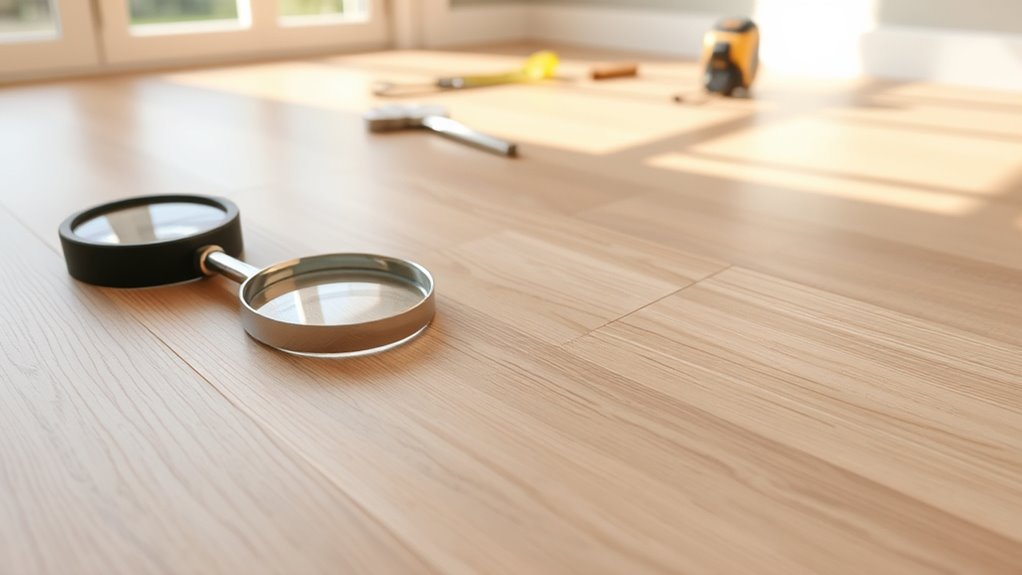
Before you can effectively fix gaps in your laminate floor, you need to pinpoint the underlying cause. Start by examining the environment for common gap causes, such as changes in humidity or temperature that lead to floor movement. Laminate expands and contracts with fluctuating moisture levels, which can create visible gaps over time. Check if improper installation contributed—insufficient expansion space around edges restricts natural floor movement, forcing planks apart. Structural issues, like an uneven subfloor, also cause gaps by preventing planks from aligning properly. Identifying whether floor movement results from environmental factors, installation errors, or subfloor problems is critical. Once you understand the root cause, you’ll gain the freedom to select the right repair approach, ensuring your laminate floor remains stable and gap-free long term.
Gather Necessary Tools and Materials
With the cause of your laminate floor gaps identified, you can now assemble the specific tools and materials required for an effective repair. Start by gathering a rubber mallet, spacers, a tapping block, and a pull bar—these tools facilitate precise alignment and secure fitting during repair techniques. You’ll also need appropriate flooring materials such as matching laminate planks or laminate floor filler, depending on the gap size and cause. Additionally, keep a measuring tape and utility knife handy for accuracy and trimming. If moisture or swelling caused the gaps, consider a moisture barrier or sealant to prevent recurrence. Having these tools and materials ready guarantees you can execute repairs efficiently, maintaining your flooring’s integrity and appearance without unnecessary delays or compromises.
Clean the Gaps Thoroughly
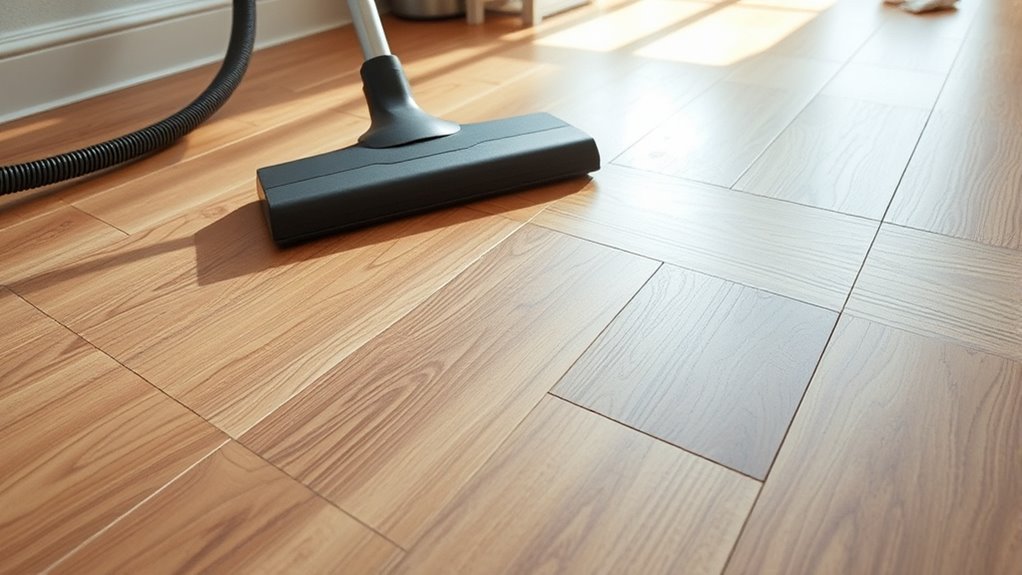
Before filling the gaps, you’ll need the right tools like a vacuum with a crevice attachment and a soft brush to remove dust and debris. Make sure to clear out all particles to guarantee proper adhesion of any filler or sealant. Thorough cleaning prevents future issues and ensures a seamless repair.
Tools for Cleaning
To clean laminate floor gaps effectively, you’ll need a few specialized tools designed to reach and remove debris trapped between planks. Proper floor cleaning and gap maintenance require precision, so equip yourself with the right instruments. Essential tools include:
- A narrow crevice vacuum attachment for suctioning loose dirt
- A soft-bristled brush to dislodge particles without damaging surfaces
- A microfiber cloth for wiping residue
- Compressed air canisters to blow out fine dust
- A plastic scraper to gently loosen stubborn debris
Each tool plays a critical role in ensuring gaps are thoroughly cleaned without harming the laminate finish. By using these, you maintain the floor’s integrity and prevent further damage caused by dirt accumulation. Preparing adequately now will make subsequent repair steps more effective and efficient.
Removing Debris Effectively
A thorough removal of debris from laminate floor gaps is crucial for a successful repair. You’ll encounter various debris types such as dust, dirt, pet hair, and small particles lodged within the gaps. Start by using a vacuum with a narrow crevice tool to extract loose debris efficiently. Next, apply compressed air to dislodge stubborn particles. For sticky or embedded substances, a plastic putty knife or a soft brush will help you scrape gently without damaging the floor. Avoid using metal tools that can scratch the laminate. Finally, wipe the gaps with a slightly damp microfiber cloth to remove residual dust. Employing these cleaning techniques guarantees the gaps are pristine, allowing fillers or repair materials to adhere properly and deliver a durable, seamless finish.
Use Wood Filler or Putty to Fill Small Gaps
Although small gaps in laminate flooring might seem minor, using wood filler or putty offers a durable solution to restore a smooth surface. To effectively address these gaps, master precise wood filler techniques and putty application. Begin by selecting a filler that matches your floor color. Clean the gap thoroughly, then use a putty knife to press filler into the space. Follow these steps:
Small gaps in laminate flooring can be seamlessly repaired using color-matched wood filler and precise application techniques.
- Choose a flexible wood filler compatible with laminate
- Clean and dry gaps before application
- Apply filler smoothly with a putty knife
- Remove excess filler promptly to avoid residue
- Allow filler to cure fully before foot traffic
This method guarantees a seamless finish, preserves flooring integrity, and grants you the freedom to walk confidently over your repaired laminate floor.
Adjust or Reinstall Planks for Larger Gaps
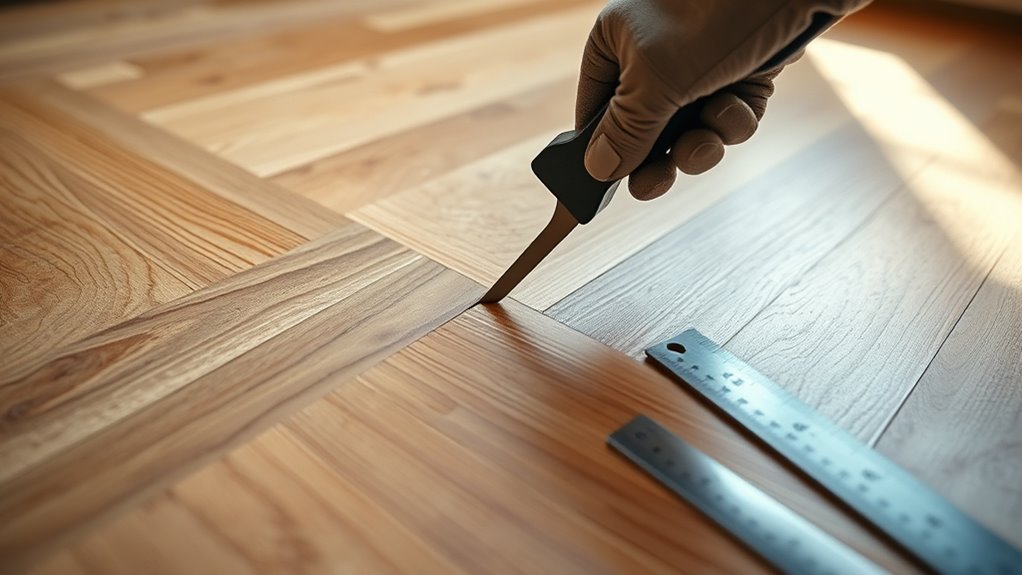
When gaps in your laminate flooring exceed the capacity of fillers, you’ll need to adjust or reinstall the affected planks. Begin by carefully removing the baseboards and trim near the gap to access the planks. Gently pry up the loose or misaligned planks using a tapping block and pull bar to avoid damage. For adjusting planks, realign them by pressing firmly into place, ensuring the tongue-and-groove joints lock tightly. If adjusting planks doesn’t close the gap, proceed with reinstalling sections. Remove the problematic planks completely, inspect the subfloor for unevenness, and correct any issues. Then, reinstall the planks, maintaining proper alignment and tight joints. After securing the planks, replace the baseboards and trim. This precise approach restores your floor’s integrity and prevents further gaps.
Maintain Proper Humidity to Prevent Future Gaps
Since laminate flooring is sensitive to moisture changes, maintaining proper humidity levels is crucial to prevent gaps from forming. You need consistent humidity control to preserve the moisture balance in your flooring environment. Aim to keep indoor humidity between 35% and 55%. To achieve this, follow these steps:
- Use a hygrometer to monitor humidity levels regularly.
- Employ humidifiers in dry seasons to add moisture.
- Use dehumidifiers or air conditioners in humid conditions to reduce moisture.
- Guarantee adequate ventilation to stabilize indoor air quality.
- Seal any leaks or water sources that may disrupt moisture balance.

